Thailand Tropical Jungle Plants: edible and medicinal
wild plants of Southern Thailand
All Paddle Asia tours are educational. Here are just a few of
the many wild edible plants we encounter on our jungle
survival tours in Khao Sok National Park and Phang Nga
Province. The tropical jungle in Thailand offer a wide array
of useful edible and medicinal plants. Rural villagers still
utilize this bounty. Here is a brief selection of the many
plants available.
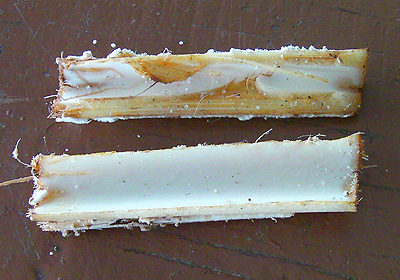 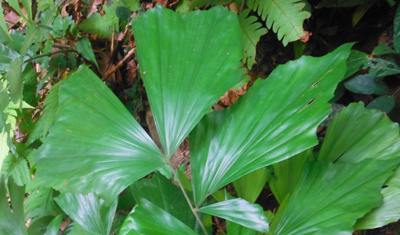
Fishtail Palm
The inner core of the Fishtail Palm offers a sweet
starch (carbohydrate) along with a refreshing taste.
The downside is that you have to kill the whole tree
to get it, but in a survival situation this is a good
idea. In Southern Thailand, this is a very common
plant. It can be found in both coastal areas as well
as thick old-growth jungles.
|
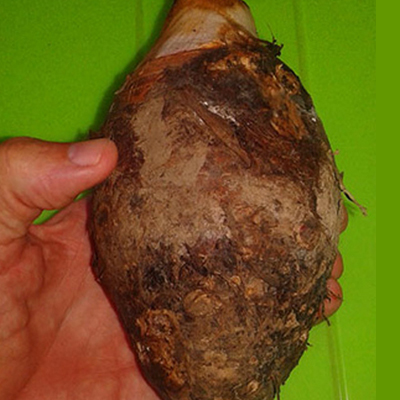
Taro
Taro is fairly common in the wild. If not taro, the
colocasia family is readily available. The root or
corm is the standard part that you eat, though the
stems and leaves are also edible. The stems and leaves
must be cooked to dissolve the raphides (sharp calcium
oxalate crystals). Once dissolved, they are a form of
usable calcium.
The root is a very good source of carbs. 100 grams of
root contains about 26 grams of carbohydrate. This is
about 20% of your daily requirement, so a couple of
roots could be equal to about half of your daily carb
requirement, which is certainly enough to keep your
energy level up and your brain functioning properly.
Taro is a decent source of B-complex vitamins.
Minerals include zinc, magnesium, copper, iron,
manganese, and of potassium.
If you eat the leaves, which you should in a survival
situation, you can add vitamin C (100 grams provide
approximately 80% RDA), Phosphorus, Calcium, and trace
amounts of Selenium and other minerals.
In sum, finding a patch of Taro in the wild would go
a long way towards enjoying your involuntary camping
trip.
|
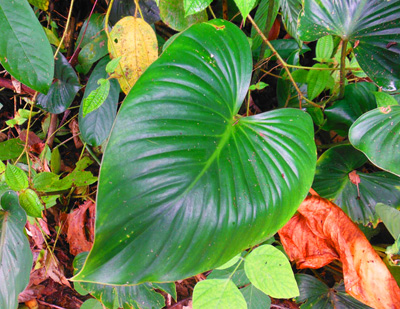
Colocasia
Taro and other plants in the Colocasia family
(Araceae) are quite common in this region. They also
contain all of the essential amino acids and in the
proper usable proportions. Your body stores
non-essential amino acids, so eating other wild plants
in a survival situation would provide you with a
complete protein. You DO NOT have to eat these amino
acids in the same meal... again, your body stores the
amino acids to be combine when needed.
Some wild fruits would provide some of the missing
aminos. The legumes from the Sataw tree seeds (Parkia
speciosa) are the perfect compliment to Taro.
This tropical fruit contains calcium, phosphorous,
iron and vitamin C.
|

Wild Betel Leaves
Wild Betel is in the Piperaceae family. It’s called
bai chaphlu in Thai. This leaf is a key ingredient in
a traditional Thai snack called ‘Miang kham’. You form
a bowl with the leave and add chopped up chilies,
onions, roasted coconut, small dried shrimp, ginger,
peanuts, and a sweet sauce. Each crunch releases a
host of mixed flavors.
Along with the usual green leaf nutritional values as
far as vitamins and minerals are concerned, Betel
leave are medicinally valuable as a cough suppressant,
supposedly influential in curing malaria, an
analgesic, and a digestive aid.
|

Ginger family
The Ginger family (Zingiberaceae) is big in Thailand.
Globally, there are over 1,300 species! Ginger has
B-5, B-6, potassium, manganese, copper, and magnesium.
Gingerols, the oils present in ginger, help the
gastrointestinal tract as well as being an analgesic,
a mild sedative, anti-inflammatory, and having
antibacterial properties. Ginger is good for
combatting motion sickness.
|
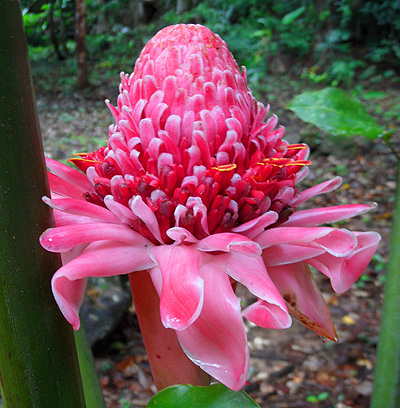
Torch Ginger
Torch Ginger flower (genus Etlingera) contains
approximately 4.5 grams of carbohydrate per 100 grams.
|
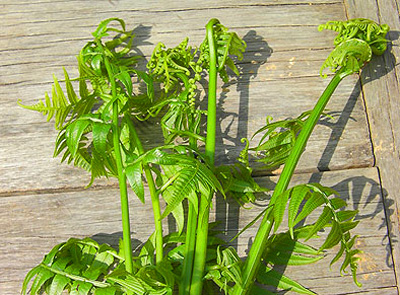
Paco Fern (Diplazium Esculentum) – Pak Goot in Thai
The young ferns fronds are quite nice, especially the
tops. This is equivalent to the rather expensive and
difficult to find Fiddlehead Ferns elsewhere. It’s a
treat eating this tasty plant.
They can be eaten raw, but Thais usually blanch them
first. Eating them raw would provide more nutritional
value.
There is only just over 30 calories in 100 grams of
Pak Goot, but the other nutrients make it a very
worthwhile addition to your survival diet. There are
antioxidants, vitamins (especially A and C), plus
omega-3 and omega-6 essential fatty acids. The Beta
Carotene content is also fairly high. Minerals include
potassium, iron, manganese, and a bit of copper.
|
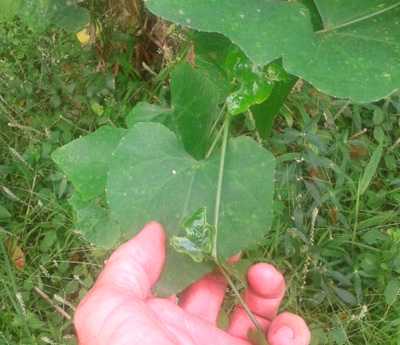
Ivy Gourd - Pak Tamlueng
This climber is Coccinia grandis. The leaves, young
shoots, and berries are all edible. This wild plant is
very common and it’s used in a few popular Thai
dishes.
Medicinally, this is a wonder plant! It’s
anti-inflammatory, used to heal wound, has anti
convulsive properties, used to treat respiratory
inflammation, anti ulcer, a cough suppressant, an
astringent poultice, used to treat diabetes, gout and
skin diseases, and it’s used to calm a fever.
|

Fireweed
One of the most tasty plants in the jungle and it's
fairly common. This is called Fireweed (Erechtites
hieracifolia).
I can't describe the flavor other than it tastes
'healthy'.
|
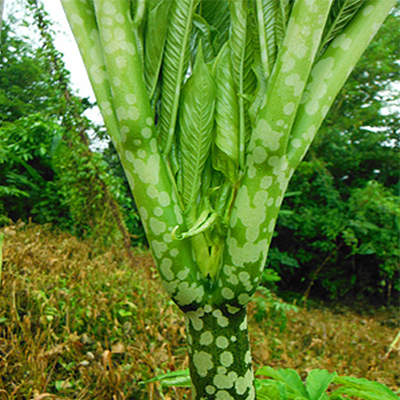
Elephant Foot Yam
Elephant Foot Yam (Amorphophallus paeoniifolius) has
an edible tuber root that is antibacterial, low on the
glycemic index, and high in omega 3 fatty acids. It
has vitamin A, C, B6 and the minerals calcium,
potassium, phosphorous, magnesium, and small amounts
of zinc, copper and selenium. It is fairly common in
the wild.
|
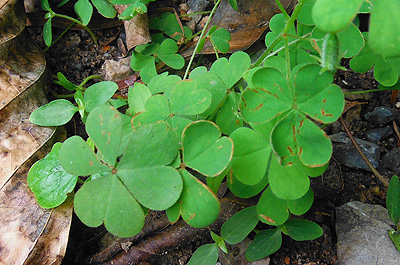
Wood Sorrel
Wood Sorrel (family Oxalidaceae) leaves, flowers,
seeds, sprouts, and roots are all edible. It is very
similar in look and taste to clover.
Wood Sorrel is packed with vitamins and minerals,
including calcium, chromium, magnesium, niacin,
phosphorus, potassium, thiamine, vitamin C, lecithin,
vitamins A, vitamin E, B2 (Riboflavin), B3 (Niacin),
iron, zinc, and selenium.
Approximately 70% of the caloric value of Wood Sorrel
is in the form of amino acids. Wood Sorrel is not a
complete protein, but if eaten with something that
supplies the missing amino acids, it would make a
respectable protein supplement.
When in the sprout form, which is always the most
nutritious stage in a plant's life, 100 grams of Wood
Sorrel provides 4 grams of protein.
Wood Sorrel flowers are, of course, high in
carbohydrates (sugar) and as sugar is converted to
glucose, which is the brain's fuel, you would
definitely be doing yourself a favor by eating as many
clover flowers as possible.
So, in a survival situation, you should grab all of
the Wood Sorrel you can find, pull up the roots too if
possible, and eat it all.
|
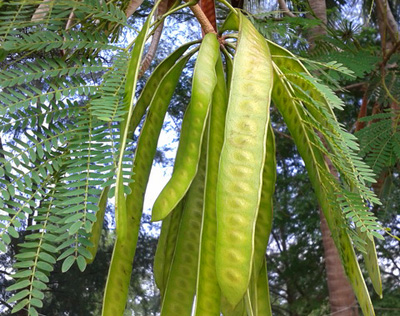
Lead Tree
This small tree is a relative of both the peanut
family (leguminosae) and the Mimosa family
(Minosoideae). It's very common throughout southern
Thailand.
The shoots and young leaves are edible. They are
often eaten raw with chilli paste.
If not cooked however, the tannic acid can be a bit
strong. In fact, this plant used to be used to treat
leather.
|
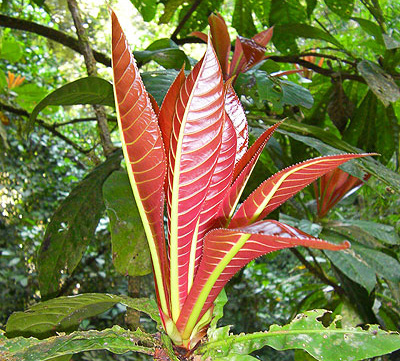
Fig (Ficus)
The young leaves of this particular ficus species are
edible. They don't have a strong taste. I'm sure they
would have some nutritional value. They are plentiful,
so they would be a good choice in a survival
situation.
|
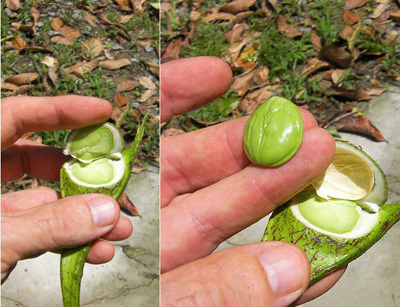
Stinky Bean ( Parkia speciosa)
This tree that is common in the tropical jungles of
southern Thailand comes into seed in the early summer.
It's called Sataw in Thai. When they're ready, Thais
from all walks of life crave them despite the fact
that they give you very bad breath.
The young leaves are edible, but it's the seeds that
the Thais really desire. They dip the raw or roasted
seeds chillie paste and they cook them in curries.
|
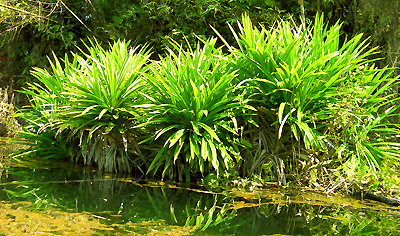
Bai Toey (Pandanus amaryllifolius)
Bai toey leaves (in Thai) are common in Thai markets.
This popular plant actually sells out quickly most of
the time as it's so prized. The leaves can be boiled
to make a lovely sweet tea. An extract is made from
the leaves to put in candies and sweet bread-type
snacks. You can also wrap meats in these leaves when
grilling to add flavor.
Nutritionally, there is some carbohydrate value, some
C complex, some B vitamins, and it has antioxidant and
liver detoxing properties.
Though cultivated in some areas, this is a wild
native plant. It grows in abundance in moist area,
especially around water. This photo is from Khao Sok
National Park.
In a survival situation, adding some leaves to your
boiled water adds some carbs and it also makes it
taste better, thus helping your morale.
Sprinkle tea made from boiling the leaves to keep
insects out of your camp or you can rub it on your
skin as mosquito repellent.
|
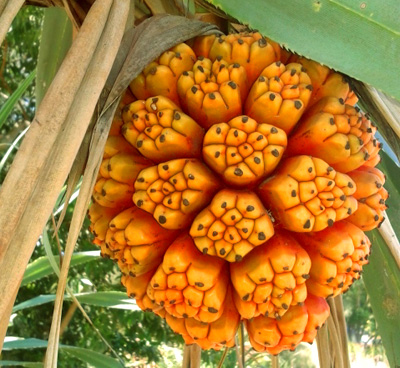
Screw Pine Pandanus
Screw Pine (Pandanus utilis) has a small amount of
edible pulp in the seeds. It’s a lot of work to get at
it, but if you’ve got nothing better to do, it’s
probably worthwhile.
The ‘utilis’ part of the name is due to the
usefulness of the strong fibers of the prop root
system. The leaves are superb for weaving. They are
very pliable and strong.
|

Broad Leaf Ginseng
All parts of the Broad Leaf Ginseng plant (Talinum
triangulare) are edible. This is one of the wonder
plants. It’s anti inflammatory, anti fungal and it’s
anti bacterial. As such, it is used both internally
and externally. Externally, the crushed leaves are
used to combat swelling and inflammation. Internally,
it’s used to combat anemia, gastrointestinal issues,
diabetes, diarrhea, peptic ulcers, various
inflammations, measels, high blood pressure, and it
has been used in cancer patients. As a digestive aid,
this plant has more pectin than apples, along with the
necessary pectinase to break down the pectin.
Pectinase is a polysaccharide that is found in the
plant’s cell walls.
The amino acid content is impressive. It has vitamins
A, C, B complex, and E. Minerals include calcium,
potassium, magnesium, manganese, zinc, and trace
amounts of cadmium and copper.
This plant has oxalic acid, so those who have kidney
stones, gout or rheumatoid arthritis should use
caution.
|
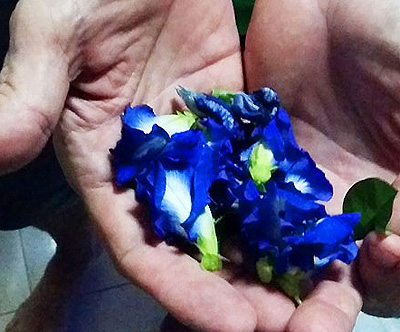
Butterfly Pea
This is the Butterfly Pea (Clitoria ternatea) or Dok
Anchan in Thai. The most common version is purple, but
there is also this white one. It makes a wonderful tea
that has a calming effect. When you boil the purple
version of these flowers it makes a lovely blue tea.
If you add lime, the acid actually makes it turn a
beautiful purple tea.
This tea also has antioxidant properties and thus
boosts body immunity.
|
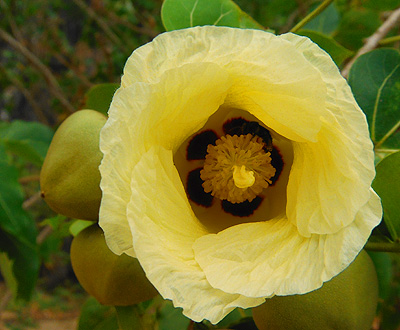
Sea Hibiscus
The amazing Sea Hibiscus (Hibiscus tiliaceus) has an
edible flower and young leaves. Though considered
famine food, you can eat the young leaves, inner bark,
and roots. They don't taste good, but they are edible.
The bark is some of the best rope-making material
available. The wood is some of the best for starting a
fire, both and tender and kindling. It's also
extremely good for making a friction fire either with
a bow and drill set or as a fire plough.
|
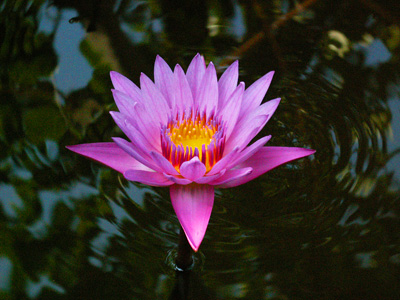
Water Lily
You can eat most of the Water lilies (Nymphaea
pubescens). The young leaves and unopened flower buds
are edible. Boil them first. The seeds are high in
carbohydrates, amino acids, and oil (calories).
You can actually roast them and then grind them into
a flour if you wish. The rhizomes (roots) are edible
as well.
|
|























